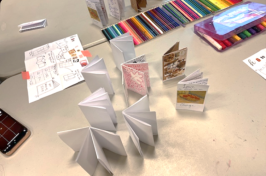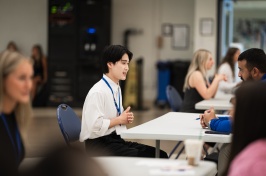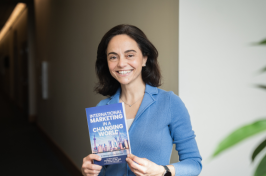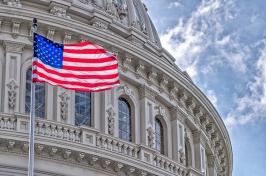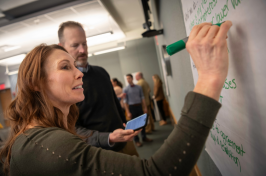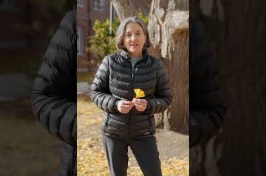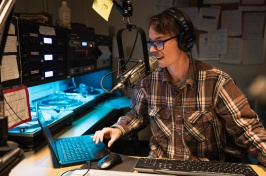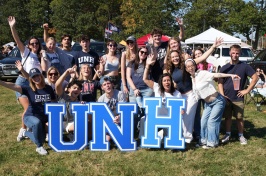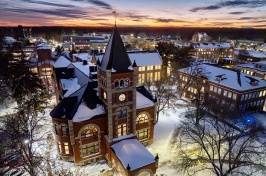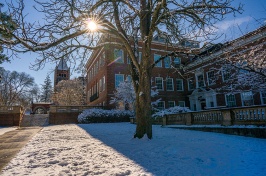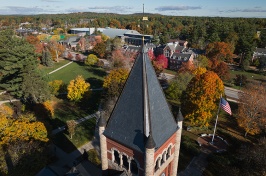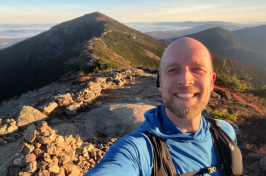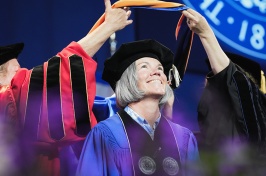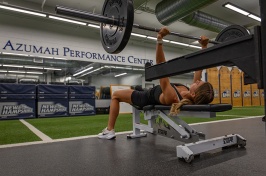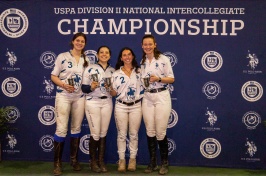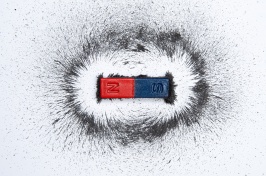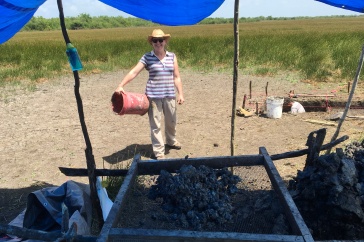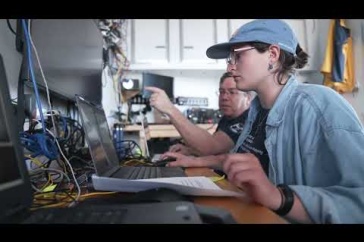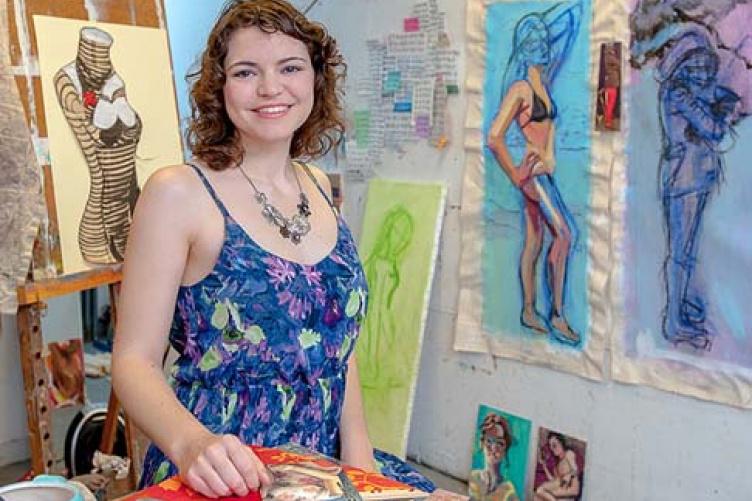
Jennifer Lindsay, surrounded by her own work, immersed herself in Chinese culture.
Is China more open now for artists than it was in the 1980s? While this query sounds simple, Jennifer Lindsay ’14 knew it would be a complex question for Chinese artists. A studio arts and international affairs major, Lindsay, from Pembroke, N.H., spent last summer in Beijing to research this question thanks to a UNH International Research Opportunities Program (IROP) grant.
All Signs Pointed to China
From the ages of three to eight, Lindsay lived in Taiwan. She notes, “Since then, I’ve always felt strongly connected to Chinese culture.” At UNH through the Confucius Institute, she began to study Mandarin in earnest. With a fellowship at the UNH Museum of Art, she helped to install an exhibition of Chinese contemporary art. In addition to her art courses, Lindsay took an independent study with Professor Chris Reardon focused on contemporary Chinese history and politics.
In the fall of 2011, she studied abroad in Beijing at the CET Academic Program hosted by Capital Normal University. This gave her both an academic and social base in the city. She formed a strong mentoring relationship with the program’s director, Professor David Moser, who would later become her foreign mentor for her research project. She was introduced to the arts community through an internship at a design firm located in a neighborhood known as the 798 Art Zone.
But it was a fellow study abroad student’s research paper on film and gallery censorship that piqued her interest. And then there were the headlines concerning China’s most famous avant-garde artist, Ai Weiwei, who was arrested that spring and held for 81 days. Weiwei, a political activist, often does work that is highly critical of the Chinese government. He is known for his 2009 sculpture, Remembering, constructed of children’s backpacks, which commemorated the thousands of schoolchildren who died in poorly constructed schools during the 2008 Sichuan earthquake. And, he was the design consultant for the Beijing National Stadium, known as the “bird’s nest.”
Yearning
Back at UNH, Lindsay knew she wanted to return to Beijing and research questions about art and freedom of expression in China today.
She successfully applied for the IROP grant with Professor Reardon as her faculty mentor.
The official title of her project became “Contemporary Art with Chinese Characteristics: Relations Between Beijing Artists and the Chinese Government Post–1989.” Her title references a famous quote by Deng Xiaoping, the reformist leader of China after Mao. “Post–1989” refers to the student uprising and call for democracy in Tiananmen Square.
Lindsay hypothesized that looking at work exhibited in Beijing galleries would be a good “state-of-the-art” indicator.
“I expect the lives of ordinary Chinese artists who attempt to express their opinions through their art reveals a very different picture from the headline grabbing current events of the high-profile political persecution of artists such as Ai Weiwei,” writes Lindsay. “As I learned in Professor Moser’s class… ‘self-censorship’ is more common than explicit government-mandated censorship in Chinese galleries.”
In Beijing, Lindsay established a home base at the Red Gate Residency for foreign artists and scholars. Then, she embarked on her project to interview Chinese artists.
This demanded resiliency and perseverance. She hired and worked with three different translators, had three bikes stolen, and learned how to navigate the length and breadth of a city of more than 20 million people.
As her faculty adviser Professor Reardon had emphasized, in China everything is about relationships and networking. Lindsay also found this out the hard way by trying to make cold calls to artists, which simply didn’t work.
Eventually, her networking began to pay off. Of course, she wanted to fire off her questions, but in Chinese culture, “chitchat” is critical.
“My translator explained to me that in China to do business, you need to make a lot of small talk first,” Lindsay explains. “So if 50 percent of an interview was just chatting, that would be pretty good and then we’d get to the questions.
“And then, while I was furiously taking notes, my translator and subject would be talking away in Chinese,” Lindsay says.
By the end of her stay, Lindsay had interviewed 23 artists and developed a long list others, but she had run out of time.
Results and Inspiration
Even from her small sample, Lindsay found a wide range of opinions. Some artists felt artistic expression was freer and others felt that it was more restricted.
“I tentatively concluded that yes, in some ways China is freer now than it was in 1989,” writes Lindsay. “Nudity and sexuality are both acceptable to a large extent, and it’s possible to make work that is critical of society and even the government, as long as it doesn’t cross the ‘red line.’ …This includes mocking Party leadership… or depicting Mao in an irreverent way… there are limits, and these are clearly understood. An artist knowingly decides to cross, or respect, or challenge the ‘line.’”
But perhaps most significantly, Lindsay enjoyed the artistic community in Beijing. She also experimented with new media—traditional Chinese ink paints and rice paper. For large drawing projects, she tried using a projector.
“China’s art world is still very young, and by contrast to the West, it’s a creative free-for-all. Some Western artists choose to work in China,” says Lindsay. “The studios and cost of living are pretty affordable… and studios are very, very large…”
Lindsay will exhibit her artwork at the annual BA/BFA exhibition this April at the UNH Museum of Art. And solo, she will exhibit works from Beijing at the Waysmeet Center on Friday, January 31, 6 p.m., 15 Mill Road, across from C Lot.
Originally published by:
The College Letter, Newsletter for the College of Liberal Arts
-
Written By:
Staff writer | Communications and Public Affairs

